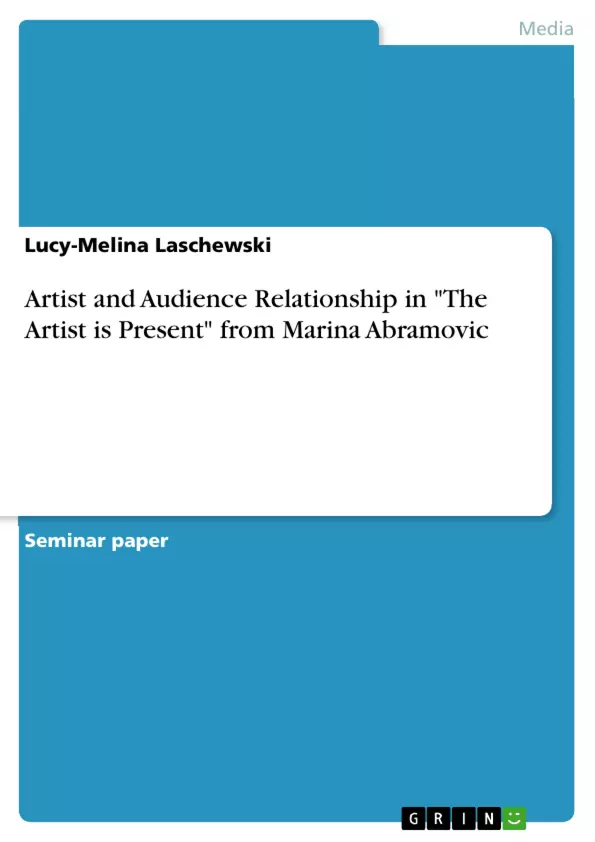The paper focuses on the audience’s participation in Abramović’s The Artist is Present. It will be analysed in terms of its constitution; further as to what extent the audience unknowingly plays in active role in simply being present. The central part of this paper is set on the relationship between artist and viewer. It will deal with how co-subjectivity, embodiment and presence, as well as the audience’s suggestibility work together to create a unique form of community during the performance. An analytical basis for this closer examination will be provided through the 2012 published documentary by the same title Marina Abramović: The Artist is Present.
First, this paper will shortly discuss performativity, embodiment and presence, and will give definitions based on, primarily, Erika-Fischer Lichte’s Ästhetik des Performativen, in order to establish a general understanding of key factors regarding performance art. Secondly, the most important aspects of Abramović’s performance will be presented. The relationship between artist and audience will be analysed and discussed according to the concerns given above. As a result, the unique character of the established community between artist and audience in this specific performance piece will be made clear. Ultimately, it will become apparent as to how the relationship between artist and audience is established through embodiment and presence.
Inhaltsverzeichnis (Table of Contents)
- Introduction
- Performativity: A definition.
- Embodiment
- Presence
- Marina Abramović
- The Artist Is Present
- Embodiment and Presence in Abramović's performance.
- Participation and resulting relationship between artist and visitor.
- Possible interferences with audience's participation.
- Conclusion
Zielsetzung und Themenschwerpunkte (Objectives and Key Themes)
This paper analyses the audience's participation in Marina Abramović's 2010 performance The Artist is Present, focusing on the relationship between artist and viewer. The main objective is to explore how co-subjectivity, embodiment, and presence contribute to the unique form of community established during the performance.
- Performativity and its impact on the relationship between artist and audience
- The role of embodiment and presence in shaping the experience of the performance
- The audience's participation and its ethical implications
- The transformation of the traditional role of the spectator in performance art
- The analysis of The Artist is Present in relation to other works by Marina Abramović
Zusammenfassung der Kapitel (Chapter Summaries)
- Introduction: This chapter introduces the concept of audience participation in performance art, particularly in Marina Abramović's work. It highlights the ethical responsibility of the audience and the potential for conflict between aesthetic experience and ethical considerations. The focus is on The Artist is Present and its unique relationship between artist and viewer.
- Performativity: A definition: This chapter defines the concept of performativity, drawing on Erika-Fischer Lichte's Ästhetik des Performativen. It discusses the characteristics of performative utterances and their application to bodily actions. The chapter emphasizes the destabilization of traditional dichotomies, such as subject/object and artist/viewer, in performance art.
Schlüsselwörter (Keywords)
This paper focuses on the relationship between artist and audience in Marina Abramović's The Artist is Present. Key concepts include performativity, embodiment, presence, participation, co-subjectivity, and the transformation of the spectator in performance art. The analysis draws upon the work of Erika-Fischer Lichte and other scholars of contemporary performance.
- Arbeit zitieren
- Lucy-Melina Laschewski (Autor:in), 2019, Artist and Audience Relationship in "The Artist is Present" from Marina Abramovic, München, GRIN Verlag, https://www.hausarbeiten.de/document/888888


